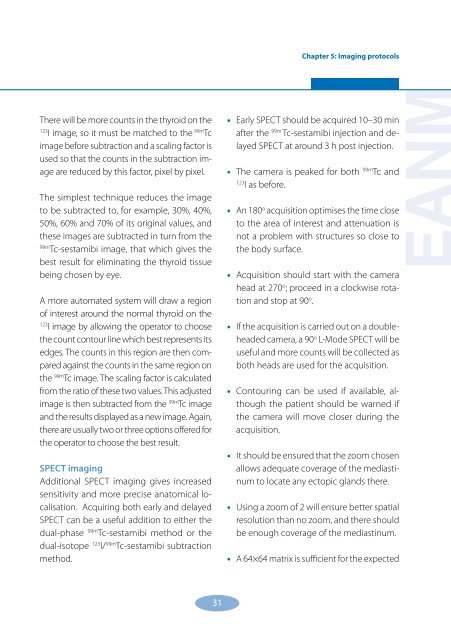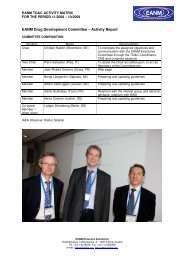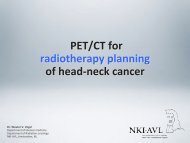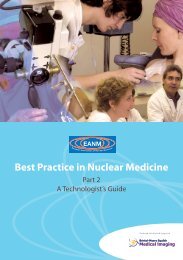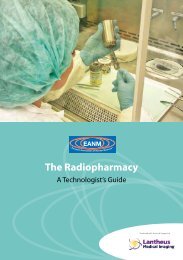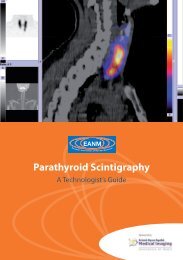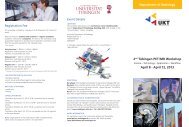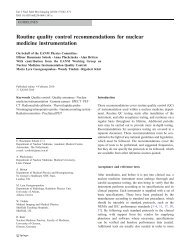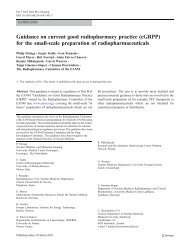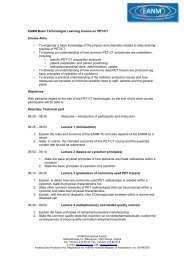Parathyroid Scintigraphy - European Association of Nuclear Medicine
Parathyroid Scintigraphy - European Association of Nuclear Medicine
Parathyroid Scintigraphy - European Association of Nuclear Medicine
Create successful ePaper yourself
Turn your PDF publications into a flip-book with our unique Google optimized e-Paper software.
There will be more counts in the thyroid on the<br />
123 I image, so it must be matched to the 99m Tc<br />
image before subtraction and a scaling factor is<br />
used so that the counts in the subtraction image<br />
are reduced by this factor, pixel by pixel.<br />
The simplest technique reduces the image<br />
to be subtracted to, for example, 30%, 40%,<br />
50%, 60% and 70% <strong>of</strong> its original values, and<br />
these images are subtracted in turn from the<br />
99m Tc-sestamibi image, that which gives the<br />
best result for eliminating the thyroid tissue<br />
being chosen by eye.<br />
A more automated system will draw a region<br />
<strong>of</strong> interest around the normal thyroid on the<br />
123 I image by allowing the operator to choose<br />
the count contour line which best represents its<br />
edges. The counts in this region are then compared<br />
against the counts in the same region on<br />
the 99m Tc image. The scaling factor is calculated<br />
from the ratio <strong>of</strong> these two values. This adjusted<br />
image is then subtracted from the 99m Tc image<br />
and the results displayed as a new image. Again,<br />
there are usually two or three options <strong>of</strong>fered for<br />
the operator to choose the best result.<br />
SPECT imaging<br />
Additional SPECT imaging gives increased<br />
sensitivity and more precise anatomical localisation.<br />
Acquiring both early and delayed<br />
SPECT can be a useful addition to either the<br />
dual-phase 99m Tc-sestamibi method or the<br />
dual-isotope 123 I/ 99m Tc-sestamibi subtraction<br />
method.<br />
1<br />
•<br />
•<br />
•<br />
•<br />
•<br />
•<br />
•<br />
•<br />
Chapter 5: Imaging protocols<br />
Early SPECT should be acquired 10–30 min<br />
after the 99m Tc-sestamibi injection and delayed<br />
SPECT at around 3 h post injection.<br />
The camera is peaked for both 99m Tc and<br />
123 I as before.<br />
An 180 o acquisition optimises the time close<br />
to the area <strong>of</strong> interest and attenuation is<br />
not a problem with structures so close to<br />
the body surface.<br />
Acquisition should start with the camera<br />
head at 270 o ; proceed in a clockwise rotation<br />
and stop at 90 o .<br />
If the acquisition is carried out on a doubleheaded<br />
camera, a 90 o L-Mode SPECT will be<br />
useful and more counts will be collected as<br />
both heads are used for the acquisition.<br />
Contouring can be used if available, although<br />
the patient should be warned if<br />
the camera will move closer during the<br />
acquisition.<br />
It should be ensured that the zoom chosen<br />
allows adequate coverage <strong>of</strong> the mediastinum<br />
to locate any ectopic glands there.<br />
Using a zoom <strong>of</strong> 2 will ensure better spatial<br />
resolution than no zoom, and there should<br />
be enough coverage <strong>of</strong> the mediastinum.<br />
•<br />
A 64×64 matrix is sufficient for the expected<br />
EANM


